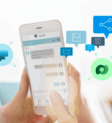9 Major Chatbot Trends for 2021

It goes without saying that in 2020, AI & chatbots have accelerated digital transformation journeys of enterprises across the globe.
Due to the unique challenges posed by the pandemic, customers’ shopping habits transitioned to the online mode; simultaneously, the uncertainty and panic caused an unprecedented increase in contact center call volume, thus increasing the burden on support and call-center staff.
The pandemic also put unprecedented pressure on the HR and IT teams as they were burdened with hundreds of emails and calls from employees concerned about work status, pay check, and IT issues and incidents.
Organizations, particularly those in the airlines, government, healthcare, banking, and insurance industries, received hundreds of thousands of calls from anxious customers regarding flight status, cancellations, diagnosis information, health insurance, common pandemic queries, and much more.
As a result, COVID-19 started the urgency for organizations to accelerate digital transformation journeys with deploying AI chatbots as a key strategic priority.
An increasing number of organizations started using chatbots to service both customers and employees, reducing costs and easing the load off support agents by providing a self-service route to answer queries.
Organizations like Services Australia saw a 600 percent surge in the use of its Microsoft Cortana-powered digital assistants amid the pandemic.
Hence in 2020, chatbots played a major role in the fight against the pandemic by servicing customers and supporting remote employees and will continue to do so in the next year as well.
Let’s learn about the top 9 trends that will define the world of chatbots in 2021.
Top 9 Chatbot Trends for 2021
Trend #1: Low code platforms
The pandemic necessitated companies to be more agile in their operations. This led to the need for low-code development platforms and faster deployment of business apps. Due to the increased and urgent need for chatbots in the new normal, enterprises leveraged low-code chatbot platforms because of their ability to allow less experienced users build chatbots quickly. Employees across departments, with little or no coding experience, have infused agility in operations by deploying chatbots for HR automation, service desk management, customer support, sales support, and much more.
In 2021 and beyond, we will see more and more companies moving away from traditional framework-based chatbot development approaches to low-code development.
Low-code chatbot platforms like Microsoft’s Power Virtual Agents will be used to build and deploy chatbots on websites, social media channels and enterprise apps like Teams or Slack without the need for developer experience.
Learn More: How Low-Code Application Platforms Are Driving Agility In the New Normal
Trend #2: Convergence of Multiple Chatbots
As the adoption of chatbots boomed post COVID-19, organizations started implementing specialized chatbots for each function or department, including HR, IT, Business Intelligence, etc. As such, more and more chatbots were required to be implemented within the organization for different use cases.
Consequently, users had to interact with multiple chatbots and understand and adjust to the capabilities and diverse conversation styles of different chatbots.
With a centralized chatbot, also known as an Aggregator Bot, that links individual bots together, you can counter the issues that arise due to fragmentation across functions and provide consistent conversational experiences. The bot will act as your employees’ single virtual assistant. This will be a significant chatbot trend in 2021.
Learn More: The Aggregator Bot: Unify Multiple Chatbots Into A Single Bot
Trend #3: Human-in-the-loop
Training, calibrating and explaining AI-enabled systems requires human-in-the-loop architecture
– Gartner
Chatbot needs a human-in-the-loop feedback system to constantly learn and become intelligent. And throughout its lifecycle, a chatbot or any AI system interacts with different types of people who influence its intelligence. In the case of consumer-facing chatbot, even the smallest customer’s feedback like “click here if you are satisfied with the solution” can help improve the machine learning algorithm of chatbots. In addition to consumer training, contact center agents can also classify outliers and exceptions and help modify the chatbot training data and behaviour accordingly.
Trend #4: Going from conversation to action
In addition to chatbots, Robotic Process Automation (RPA) is one more widely adopted technology in 2020 to reduce costs. When brought together, these technologies can solve significant operational and workflow-related problems for enterprises.

By combining the automation capabilities of RPA with cognitive intelligence of chatbots, organizations can automate their processes end-to-end. An RPA powered chatbot can integrate with disparate and multiple back-end enterprise systems. RPA enables chatbots to retrieve information from these systems and handle more complex customer/employee requests and queries at scale.
Chatbots will now be able to not only handle conversations and help find information but also perform transactions on users’ behalf.
At Acuvate, we’re helping clients achieve this by integrating Microsoft Power Virtual Agents and Power Automate.
Learn More: Power Virtual Agents & Power Automate – Truly Powerful!
Trend #5: Multilingual capabilities
Only 20% of the world’s population speaks English. To amplify your reach and enhance your localization efforts, it is essential to develop bots capable of holding conversations in multiple languages.
Customers generally trust brands that deliver interactions in their native tongue or any other preferred language. Therefore, to help you reach customers worldwide and boost CSAT levels, building a chatbot in their preferred language, like French, German, Spanish, etc., is a must.
Moreover, by deploying multilingual or polyglot bots, companies save vast amounts of money, generally spent to train employees to meet varied language needs. Additionally, a multi-language bot boosts employee efficiency by shortening the query turnaround time.
Learn More: Multilingual Chatbots | Build Chatbot In Different languages
Trend #6: Supporting remote workforce
According to research by Gartner, 74% of CFOs and Finance Leaders say that they will move at least 5% of their employees to remote working permanently after the pandemic. 25% of the participants say they will move 10% of their workforce to remote working permanently.
In the wake of the current crisis, remote working will continue to be the norm in 2021. Therefore, employees will have a variety of concerns daily that will often require urgent resolution.
In times like these, a dedicated chatbot available on the beck and call will help address a lot of issues including:
- Answer FAQs related to work from home policies
- Providing information on return to workplace strategies
- Notify employees about health advisories, crisis communication, and work from home tips
- Ensure seamless recruitment and onboarding
- Track employee health
Trend #7: The human touch
Chatbots are becoming more intelligent and handling more complex conversations. The chatbots of 2021 will deliver highly meaningful, contextual, and personalized conversations with a human-like touch.
With advanced capabilities like context management, sentiment analysis, dialogue management, knowledge mining etc., they will remember conversation context, handle dialogue turns, understand the user’s emotion and respond accordingly, leading the way for more human-like conversations.
Trend #8: Personification of Bots
The need for the right chatbot personality becomes more prevalent in 2021. If the chatbot is built for a customer-facing function, its personality should ideally mirror that of your company’s and should be tailored keeping the end-user in mind. It should consistently represent what your brand stands for at every stage of the conversation – right from greeting the user to handling queries and signing off from the chat.
Trend #9: Evolution to Conversational Personal Assistants
In 2021 and beyond, we can see conversational personal assistants helping employees access information and complete their everyday tasks more efficiently. This means bots will be able to handle more complex tasks and conversations. A conversational personal assistant will be used for scheduling meetings, accessing a document, assigning a task to a team member, raising an IT ticket, requesting HR information and so on.
Get Started
The COVID-19 pandemic has brought to the forefront the pressing need for organizations to build resiliency, agility, and scalability in operations.
Chatbots have eased the pressure of handling routine, mundane queries and tasks, freeing up support personnel to focus on more critical and productive jobs.
And as they continue to improve employee support, boost productivity, and take CSAT levels to new heights in these turbulent times, chatbots are paving the way forward for a new level of quick, personalized, and delightful user experiences.
If you’d like to learn more about this topic, please feel free to get in touch with one of our chatbot experts for a personalized consultation. You might also be interested in exploring our enterprise chatbot builder platform (BotCore) for further insights.
Abhishek is the AI & Automation Practice Head at Acuvate and brings with him 17+ years of strong expertise across the Microsoft stack. He has consulted with clients globally to provide solutions on technologies such as Cognitive Services, Azure, RPA, SharePoint & Office 365. He has worked with clients across multiple industry domains including Retail & FMCG, Government, BFSI, Manufacturing and Telecom.






Abhishek Shanbhag